Injections of platelet-rich plasma (PRP) are commonly offered to men with erectile dysfunction (ED) by a variety of healthcare professionals at high cost, despite the lack of evidence-based guidelines to back its use or any standardized protocols or duration of treatment, according to a new study.
Investigators researched over 100 clinics in eight populous metropolitan areas of the United States and found that these injections were widely available. The mean cost of each injection was over $1500, and treatment ranged from one to an indefinite number of injections.
“The take-home message for patients is to approach purported ‘miracle cures’ with skepticism and realize that many cash-based treatments rely on salesmanship,” senior author Sriram Eleswarapu, MD, PhD, assistant clinical professor of urology, University of California, Los Angeles, told theheart.org | Medscape Cardiology.
“Doctors and other healthcare workers should be mindful of the potential for medical harm and financial toxicity. Guidelines-conformant, evidence-based care should take precedence while investigational therapies like PRP are being studied in clinical trials,” he said.
The study was published online May 26 in JAMA Network Open.
Consumerization of Sexual Health
PRP, often called the “Priapus shot” or “P-shot,” Eleswarapu said, “has emerged in a variety of medical and cosmetic applications, and there is some thought that PRP injections into the penis might be useful as a regenerative therapy of ED; however, there are no good data suggesting that PRP actually works for this purpose.”
The American Urological Association (AUA) and the Sexual Medicine Society of North America have issued statements that PRP is an investigational treatment that should not be offered for payment, Eleswarapu points out. In fact, the AUA erectile dysfunction guideline states that men with ED “should undergo a thorough medical evaluation and offered a variety of proven treatment options, rather than investigational therapies.”
Despite the absence of clinical trial data on PRP for ED, “many providers have begun to market this treatment and charge high fees, with no guarantee that it helps. Unfortunately, men are desperate for cures and are willing to pay for therapies with no proven benefit,” he noted.
To “characterize the landscape” of PRP injection therapy for ED, the researchers used a “secret shopper” approach — a market research method that involves using a script to inquire about products and pricing in service industries, they note.
Using an internet search, they identified 109 clinics that offered PRP for ED in eight major metropolitan areas (Atlanta, Boston, Dallas, Houston, Los Angeles, New York, Philadelphia, and Washington, DC). The researchers contacted the clinics via telephone and used a standardized script to request information about pricing, protocols, and clinician credentials.
Clinics that did not respond were excluded from the study, leaving 90 clinics for which data were available concerning pricing and treatment duration.
Of the providers, only 9% were urologists; 22% were not physicians and included chiropractors, integrative healthcare providers, naturopaths, nurse practitioners (NPs), and physician assistants (PAs). The most common providers were family medicine physicians (almost 14%), NPs (almost 14%), internal medicine practitioners (11%), and “unknown” or “other” providers (12%).
Other provider specialties included anesthesiology, emergency medicine, general surgery, obstetrics/gynecology, oncology, orthopedic surgery, plastic surgery, and physiatry.
Cost ranged from a mean price of $1367 (range, $350 – $2500) in Los Angeles (n = 20 clinics) to $1580 ($1200 – $1900) in Washington, DC (n = 5 clinics). Except for the clinics in Los Angeles, the mean price in all other areas was ≥$1500.
The authors highlight the “substantial cost,” lack of standardized protocol, and the high number of nonphysicians as well as physicians who had no training in male sexual dysfunction who administered these injections. The investigators state that the findings “suggest that guideline-nonconformant care has been driven by the consumerization of sexual health.”
“Buyer Beware”
Commenting on the study for theheart.org | Medscape Cardiology, Ryan Terlecki, MD, professor and vice chair of urology, Wake Forest University School of Medicine, said it is “not surprising for those of us in practice to see what’s taking place and that it is driven by financial benefit.”
Many people in other areas of medicine have found that administering these injections is a “nice career change, and they can make a lot of money — often cash-based — with low stress and no insurance to file,” said Terlecki, who was not involved with the study.
“The message for patients is ‘buyer beware,’ and for physicians, the message is that you can give these injections, and you can make a lot of money, but it doesn’t appear necessarily to be ethical. Even when patients say that it worked, it might be a placebo response; but if you’re going to get rich off a placebo response, is that ethical?”
He noted that there do not appear to be safety concerns regarding PRP injections for ED, since the cells being used are from the patient’s own body.
“If you pay careful attention to skin preparation and how you handle the injections, there doesn’t appear to be a huge risk to anything other than the wallet and perhaps faith in the medical community, in that the provider may potentially undermine legitimate attempts to determine whether something is of benefit scientifically.”
No source of funding for the study was provided. Eleswarapu reports receiving personal fees from Metuchen Pharmaceuticals outside the submitted work. The other authors’ disclosures are listed on the original article. Terlecki receives research funding from the Department of Defense and is a consultant for Boston Scientific; he also receives grant funding from Boston Scientific and is on its advisory board.
JAMA Netw Open. Published online May 26, 2022. Full text
For more from the heart.org | Medscape Cardiology, follow us on Twitter and Facebook.
Source: Read Full Article
